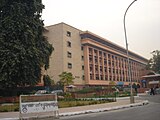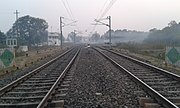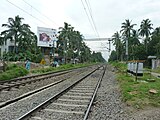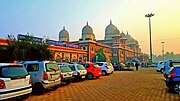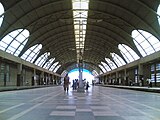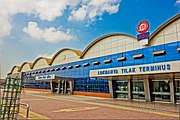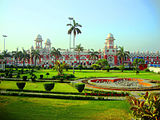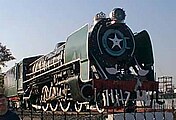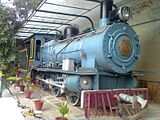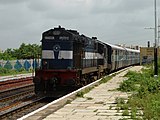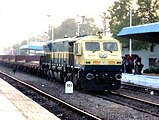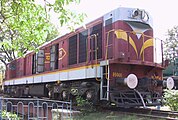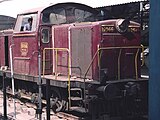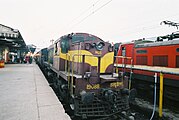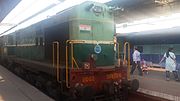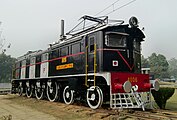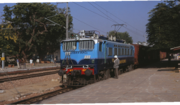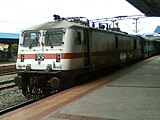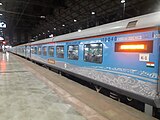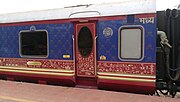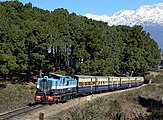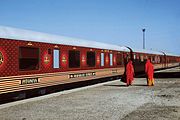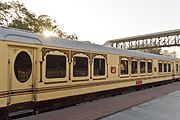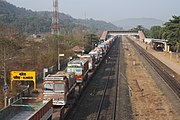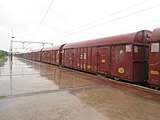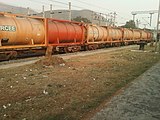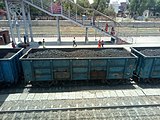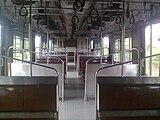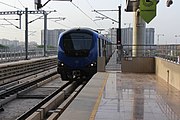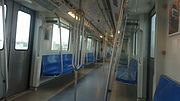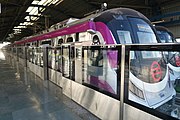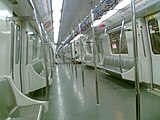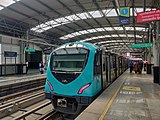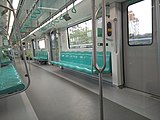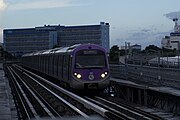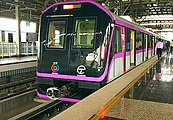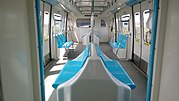Train/India
Rail transport is an important mode of transport in India. All main-line rail operations in India are handled by Indian Railways (IR), a state-owned organization of the Ministry of Railways. Except the Kolkata Metro, the urban rail transit systems across the country are operated independently of the Indian Railways.
Indian Railways
[edit]Indian Railways (IR) is India's national railway system operated by the Ministry of Railways. It manages the fourth-largest railway network in the world by size, with 121,407 kilometres (75,439 mi) of total track over a 67,368-kilometre (41,861 mi) route.
-
Rail Bhavan, New Delhi
Zones
[edit]-
Central Railway zone headquarters, Chhatrapati Shivaji Maharaj Terminus (CSMT), Mumbai
-
East Coast Railway zone headquarters, Bhubaneswar
-
Eastern Railway zone headquarters, Kolkata
-
Metro Railway, Kolkata has headquarters at Kolkata
-
North Central Railway zone has headquarters at Prayagraj
-
Northeast Frontier Railway zone has headquarters at Guwahati
-
Northern Railway zone has headquarters at Delhi
-
South Coast Railway zone has headquarters at Visakhapatnam
-
South East Central Railway zone has headquarters at Bilaspur
-
South Western Railway zone headquarters, Hubli
-
Southern Railway zone headquarters, Chennai
-
West Central Railway zone has headquarters at Jabalpur
Network
[edit]Railway tracks
[edit]-
Rail tracks near Secunderabad
-
Rail tracks near Balarampur, Purulia
-
Rail tracks near Simurali
-
Rail tracks near Jalgaon
-
Diamond crossing near Nagpur
Railway stations
[edit]-
New Delhi railway station}}
Locomotives
[edit]The locomotives of India presently consist of electric and diesel locomotives. Steam locomotives are no longer used in India, except in heritage trains. Locomotives are also called locos or engines. In India, locomotives are classified according to their track gauge, motive power, the work they are suited for and their power or model number. The class name includes this information about the locomotive. It comprises 4 or 5 letters. The first letter denotes the track gauge. The second letter denotes their motive power (Diesel or Electric) and the third letter denotes the kind of traffic for which they are suited (goods, passenger, mixed or shunting). The fourth letter used to denote locomotives' chronological model number. However, from 2002 a new classification scheme has been adopted. Under this system, for newer diesel locomotives, the fourth letter will denote their horsepower range. Electric locomotives don't come under this scheme and even all diesel locos are not covered. For them this letter denotes their model number as usual.
Steam locomotives
[edit]-
HPS 24467 Steam Locomotive
-
YP class Steam Locomotive
-
Bengal Nagpur Railway number 815. A Beyer Garratt built in Manchester by Beyer Peacock & Co Ltd
-
Steam Locomotive at Viswesarayya Technology Museum Bangalore
-
Nilgiri Mountain Railway locomotive No.37385 preserved in Delhi Railway Museum
Diesel locomotives
[edit]Electric locomotives
[edit]-
Indian locomotive class WCP1
-
Indian locomotive class WCG1
-
Indian locomotive class WAG2
Passenger trains
[edit]Express trains
[edit]Heritage and tourist trains
[edit]-
Mahaparinirvan Express (interior)
Freight trains
[edit]Category:Freight trains in India
-
Ro-Ro train
-
BCNA freight train
-
BTPN freight train
-
Coal train
-
Cargo train
Urban rail transit
[edit]Urban rail transit in India consists of suburban rail, rapid transit, monorail and tram systems. There are currently 15 operational rapid transit (also called "metro") systems in fifteen cities in India. There is a single monorail system in Mumbai. There is a single tram system in Kolkata.
-
Map
-
Map
Suburban rail
[edit]-
Chennai Suburban Railway (interior)
-
Delhi Suburban Railway (interior)
-
Kolkata Suburban Railway (interior)
Rapid transit
[edit]-
Chennai Metro (interior)
-
Delhi Metro (interior)
-
Kochi Metro (interior)
-
Kolkata Metro (interior)
-
Lucknow Metro (interior)
-
Mumbai Metro (interior)
-
Namma Metro (interior)
Monorails and trams
[edit]-
Mumbai Monorail (interior)
